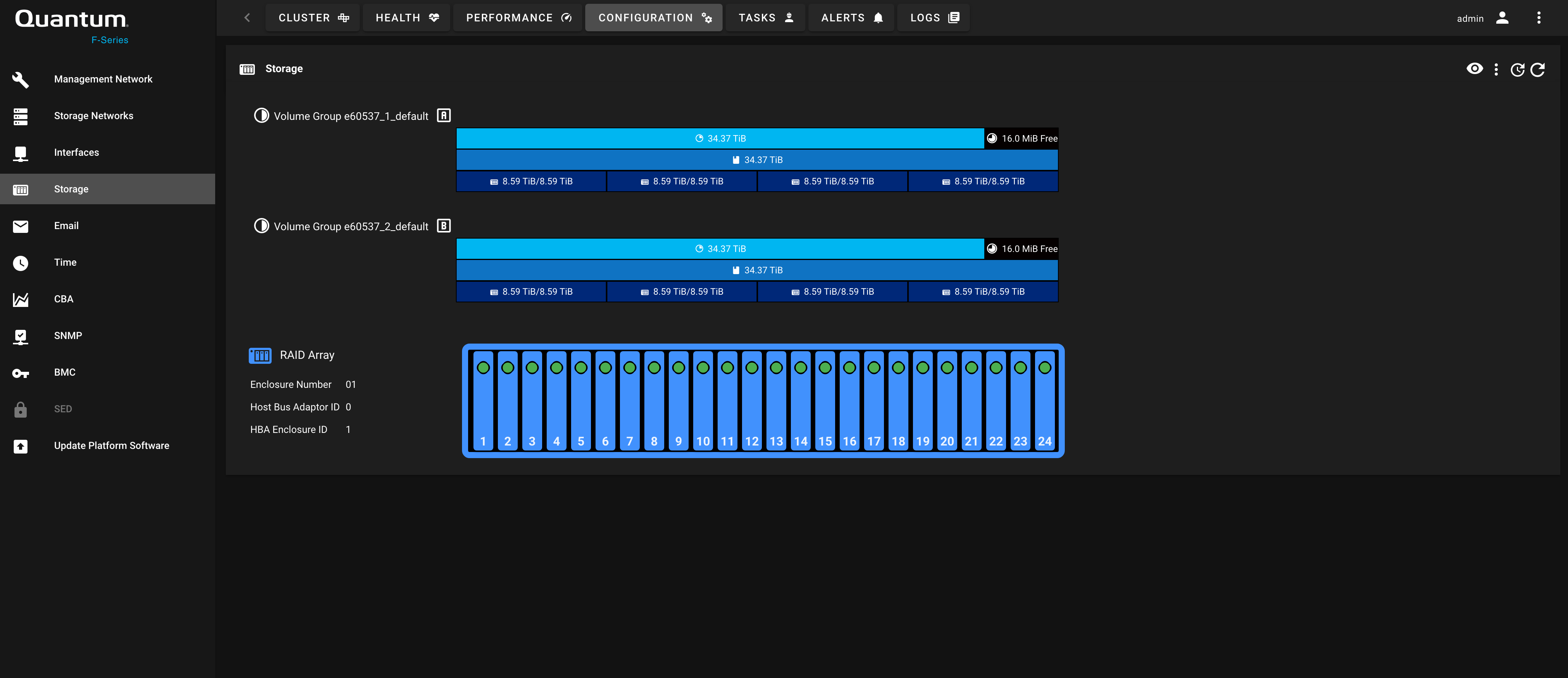F-Series NVMe Storage
Reinvent your workflows with ultra-fast NVMe storage for extreme ingest and playout, highest resolution editing, rendering, special effects, AI/ML, and large, unstructured data sets.
Break through workflow bottlenecks while reducing infrastructure costs
Major studios, corporations, research institutions and government agencies use the Quantum F-Series to accelerate the capture, edit, and finishing of high-definition content, accelerate VFX and CGI render to new levels, and develop cutting-edge augmented and virtual reality.
NVMe enables these customers to process higher-resolution content and demands not possible before, and provide massive parallel performance for large render farms, while reducing both storage and network infrastructure costs and complexity.


NVMe Tuned for Video and Image-Based Workloads
Unlike more general-purpose NVMe storage arrays, the Quantum F- Series was designed specifically for the video and image-based workloads that are critical to our customers. This content can be high- definition video used for movie, TV, and sports production, marketing and advertising content, or image-based workloads that require high- speed processing, such as the data from a satellite feed, a drone, a car used in the development of automated driver assistance systems (ADAS), and more.
The F-Series uses NVMe flash drives and the fastest system architecture to deliver ultra-fast reads and writes and to support a huge amount of parallel processing. F-Series uses the latest RDMA networking technology to provide direct access between workstations and the NVMe storage devices and provide predictable, ultra-fast network performance.
F-Series NVMe servers deliver the fastest performance recorded for StorNext environments – and speeds the movement of files and folders between NVMe storage pools and other storage pools, so customers can take advantage of the performance NVMe provides for the workloads that require it, while continuing to use lower-cost storage for data where performance is less critical.
The New Quantum F2200
The Quantum F2200 is the newest generation of NVMe storage ready to re-invent your storage workflows with performance that delivers up to 90.5 GB/s multi-client read performance–and huge capacity in a small footprint with up to 737 TB in a single 2U system.

StorNext 7 and your choice of Ethernet drivers take full advantage of the latest hardware architecture to deliver that performance and capacity in a dual-controller architecture that is fast to upgrade, and easy to manage.
Both controllers drive the 24 bays of NVMe Flash storage together for efficient load-balancing across your choice of either 4 ports of 100 GbE or 8 ports of 32 Gb Fibre Channel.
Orders of Magnitude Faster than Traditional Flash Storage
NVMe is much faster than traditional flash storage, provides extremely low latency and instant response times for workloads that require a large amount of parallel access.
Reduce Infrastructure Costs and Complexity
Quantum F-Series provides predictable, low-latency access via Fibre Channel or Ethernet, so users can achieve large-system SAN performance with Ethernet infrastructure.
Meets Performance Requirements in Less Rack Space
A single F2200 system can match the performance of much larger SSD or HDD systems—delivering extreme performance for your users in a much smaller package.
Easily Integrates into a StorNext File Storage Cluster
StorNext® 7 is highly optimized for NVMe storage to deliver shared streaming performance with ease, or create custom storage pools combining NVMe with SSD or HDD storage.
Specifications
| Specification | F2200 |
|---|---|
| Form-Factor | 2U rack-mounted chassis |
| Controller Design | Dual redundant active/active hot swappable controllers with PCIe Gen 4 system bus |
| Processors | Intel® Xeon® Gold Processor 2 CPUs/Controller |
| Memory | 256 GB (16x16 GB) DDR4-2933 DIMMs/Controller |
| Storage Drives | 24 NVMe U.2 SSD |
| Drive Capacity Options | 30.72 TB 15.36 TB 7.68 TB 3.84 TB |
| Single System Raw Capacity | 737.28 TB 368.64 TB 184.3 TB 92.16 TB |
| Single System Usable Capacity | 612 TB 306 TB 153 TB 77 TB |
| Connectivity (Ethernet Model) | 2x Dual Port 100 Gb Ethernet per Controller (total of 8 ports per system) |
| Connectivity (Fibre Channel Model) | 2x Quad Port 32 Gb Fibre Channel per Controller (total of 16 ports per system) |
| System Management Connectivity | 2x 10GBASE-T per Controller (total of 4 ports per system) |
| System Management | Integrated IPMI 2.0 + KVM with dedicated LAN |
| Serviceability | Hot-swappable power supplies Compute canister SSD Modules |
| Physical Dimensions | Height: 3.45" (88 mm) Width: 17.58" (446 mm) Depth: 32.93" (836 mm) Weight Net Weight: 86.0 lbs (39.1 kg) Gross Weight: 92.6 lbs (42.1 kg) |
| Power Supply | Two redundant, hot-swappable 2000 W power supply units |
| Power Supply Input | 200 - 240 Vac |
| Power Supply Certification | Platinum |
| Operating Temperature | 10 °C to 35 °C (50 °F to 95 °F) |
| Non-Operating Temperature | -40 °C to 60 °C (-40 °F to 158 °F) |
| Operating Relative Humidity | 8% to 85% (non-condensing) |
| Non-Operating Relative Humidity | 8% to 95% (non-condensing) |


